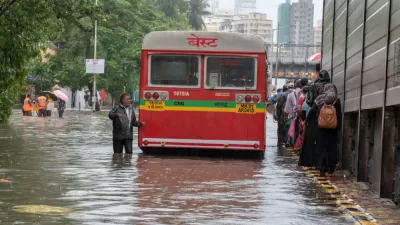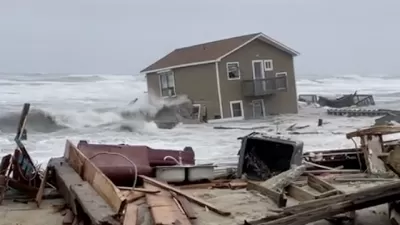A new study calls for changes to coastal management policies to better protect sandy shorelines retreating under the pressure of rising sea levels.

The reactive and piecemeal approach historically used to manage beaches in Hawaii has failed. If policies are not changed, as much as 40% of all beaches on Oahu could be lost by 2050, according to a new study by researchers at the University of Hawaii (UH) at Mānoa School of Ocean and Earth Science and Technology (SOEST). An article by Timothy Hurley shares the news of the new study.
"The team of scientists, led by graduate researcher Kammie Tavares, assessed the shoreline around Oahu that would be most vulnerable to erosion under three scenarios of sea level rise"—all estimated to occur before, and shortly after 2050, explains Hurley. The research team identified the location of shoreline hardening and beach loss and a potential timeline for increased erosion hazards. The most threatened properties fall into an "administrative erosion hazard zone," an area likely to experience erosion hazards and qualify for the emergency permitting process to harden the shoreline.
According to co-author Dr. Tiffany Anderson, assistant researcher in the Department of Earth Sciences, "We determined that almost 30 percent of all present-day sandy shoreline on Oahu is already hardened, with another 3.5 percent found to be so threatened that those areas qualify for an emergency permit today. Our modeling indicates that, as sea level rises about 10 inches (0.25 meters) by mid-century, an additional nearly eight percent of sandy shoreline will be at risk of hardening—meaning at that point, nearly 40% of Oahu’s sandy beaches could be lost in favor of hardened shorelines."
With "hardship variances," oceanfront property owners threatened by erosion have been allowed to build sea walls and other forms of shoreline armoring to protect their property. According to the study, the construction of initial sea walls destabilizes neighboring shorelines and triggers a domino effect of coastal hardening that condemns entire stretches of sandy beach to narrowing and eventual loss.
UH researchers are urging people to lobby county and state policymakers to collaborate on providing ways to help beachfront parcel owners to transition out of their precarious locations to save the sandy shoreline. Specifically, that residents support the creation of a government program to provide economic incentives tailored to individual owners and the development of a long-term plan to encourage residents to "get out of the way of our moving beaches," according to co-author Dr. Chip Fletcher, associate dean and professor at SOEST.
FULL STORY: 25 miles of Oahu beaches could be lost to coastal erosion, study finds

Planetizen Federal Action Tracker
A weekly monitor of how Trump’s orders and actions are impacting planners and planning in America.

Congressman Proposes Bill to Rename DC Metro “Trump Train”
The Make Autorail Great Again Act would withhold federal funding to the system until the Washington Metropolitan Area Transit Authority (WMATA), rebrands as the Washington Metropolitan Authority for Greater Access (WMAGA).

The Simple Legislative Tool Transforming Vacant Downtowns
In California, Michigan and Georgia, an easy win is bringing dollars — and delight — back to city centers.

The States Losing Rural Delivery Rooms at an Alarming Pace
In some states, as few as 9% of rural hospitals still deliver babies. As a result, rising pre-term births, no adequate pre-term care and "harrowing" close calls are a growing reality.

The Small South Asian Republic Going all in on EVs
Thanks to one simple policy change less than five years ago, 65% of new cars in this Himalayan country are now electric.

DC Backpedals on Bike Lane Protection, Swaps Barriers for Paint
Citing aesthetic concerns, the city is removing the concrete barriers and flexposts that once separated Arizona Avenue cyclists from motor vehicles.
Urban Design for Planners 1: Software Tools
This six-course series explores essential urban design concepts using open source software and equips planners with the tools they need to participate fully in the urban design process.
Planning for Universal Design
Learn the tools for implementing Universal Design in planning regulations.
Smith Gee Studio
City of Charlotte
City of Camden Redevelopment Agency
City of Astoria
Transportation Research & Education Center (TREC) at Portland State University
US High Speed Rail Association
City of Camden Redevelopment Agency
Municipality of Princeton (NJ)





























